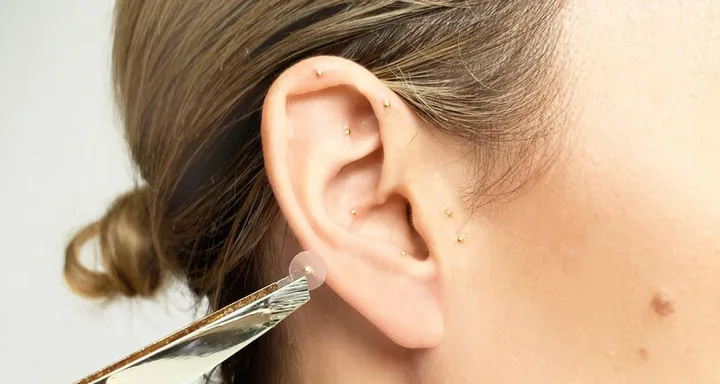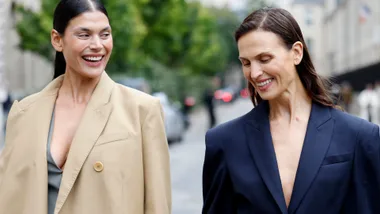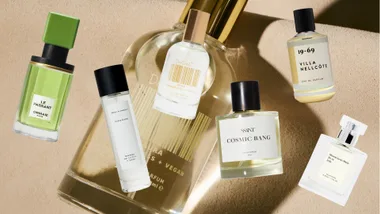Anxiety presents itself in many forms, and while there’s definitely no single solution for all, many are finding solace in strategic acupressure.
More specifically, with ear seeds.
Used in various cultures for the last 4,000 years, the strategic placement of metal pellets on the inner of the ears has been attributed to easing pain, addiction, fatigue and stress.
And when you consider the lengths many of us go to for relief in these areas, an at-home solution that’s affordable and easy certainly piques our interest.
What are ear seeds and how do they work?
Made from metal, and sometimes gold-plated, ear seeds are “acupressure pellets which adhere to the ear with clear tape and exert a therapeutic effect on the body, much like acupuncture,” says Elle Halliwell, founder of Auricle Ears Seeds.
Ear seeds are non-invasive and are simply used to stimulate points on the microsystem.
“In traditional Chinese medicine, your health depends on the flow of qi (energy) in your body. Qi travels along invisible pathways, known as meridians. Meridians are found throughout your body, including your ears,” explains cosmetic acupuncturist, Sarah Bradden.
“It was French neurologist Dr Paul Nogier who noted the ear is a somatic representation of an upside-down fetus, with various points in the ear correlating to certain points in the body,” adds Halliwell.
When applied to specific acupressure points, ear seeds provide a continuous mild pressure that “can be amplified by pressing the seed or pellet for a few seconds every few hours,” says Bradden.
Ear seeds and anxiety
Although boasting many benefits, ear seeds have become a popular way to ease anxiety and depression, the former of which Halliwell has experienced herself.
“I started using acupressure when I was pregnant, as applying pressure to the insides of my wrists was a godsend in easing my nausea. I also found applying pressure to certain points on my face and body, just with my fingers, really helpful in reducing my stress at this time, as I’d also been diagnosed with blood cancer,” she tells Marie Claire.
After having ear seeds applied by an acupuncturist, Halliwell became hooked. “It’s been a great way to manage my anxiety,” she says. “I actually had a severe anxiety attack – the first in years – at the beginning of the COVID-19 pandemic, and I found applying the seeds really effective in managing it. I also use them for sugar cravings, as sugar triggers my anxiety so it’s a win-win.”
Halliwell uses her own Auricle Ear Seeds, after discovering gold-plated alternatives were available overseas, but not in Australia. “[I] began having ear seeds applied by my acupuncturist, but didn’t like the aesthetic as they were applied with flesh-toned bandage tape.”
Halliwell’s ear seeds are now available and come in silver and gold, appearing more like stylish jewellery than a wellbeing tool. “They’re a great gift for someone who’s feeling nervous about an upcoming surgery or job interview, or is going through something emotionally or a big life change,” she recommends.
Other ear seeds benefits
Not limited to just mental health, ear seeds have a range of other benefits.
The method is also known to help with “chronic pain (especially lower back pain), insomnia and other sleep issues, infertility, digestion, menopause and migraines,” says Bradden.
“They’ve been well studied with regards to easing issues such as sciatica, neck and back pain, fatigue, addiction and stress,” adds Halliwell. “Our ears are highly innervated and acupressure can help to activate our body’s homeostasis mechanisms, bringing back into balance and assisting its self-healing abilities.”
How to apply ear seeds
Ears seeds do not puncture the skin, but instead can be easily applied at home with the readily-prepared adhesive.
“Clean the ear with an alcohol swab, peel a seed off the backing with tweezers and stick on the desired point of the ear,” says Halliwell.
“Each pack comes with a comprehensive guide to pain points and healing protocols, i.e. for stress and anxiety, hormonal balance, energy.”
Once your ear seeds are applied, Bradden recommends gently massaging them two to three times each day or when you have symptoms. “Apply pressure by rubbing the seeds with a circular motion for one to three minutes.”
“Change them regularly,” she also adds. “Ear seeds may fall off on their own after about three to five days. It’s not recommended to leave them on for more than five days, even if they’re still in place.”
Ear seeds are single-use, but a pack will generally come with multiple seeds, with Auricle Ear Seeds available in sets of 20 (from $40, auricleearseeds.com).
Removal is just as easy, best practice being to pull them away with a pair of tweezers.
How long does it take for ear seeds to take effect?
Studies have shown that with proper placement ear seeds can work both immediately for some individuals with certain conditions, and take longer – up to a few weeks with multiple sessions – for others.
“Listen to your body,” says Bradden. “Auriculotherapy is a single modality that can help, but as always it’s important to support your system in other ways.”
If you’re already receiving acupuncture treatment, Halliwell advises using ear seeds in combination with or between sessions.
Are there any downsides to ear seeds?
Ears seeds are very user-friendly and most packs will come with a comprehensive for safe use.
“Sometimes, when a point is ‘active’, the ear seed will make the ear feel sore, tender and sensitive to touch,” says Bradden. “This is normal.”
“If discomfort persists you can remove the seeds and reapply [a new set] at a later time. This discomfort is different from a skin irritation; any swelling then remove the seed immediately.”
If you are pregnant or sensitive to nausea or dizziness, consult with your doctor.










